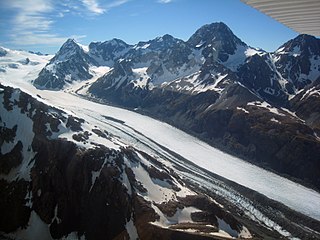
Aoraki / Mount Cook is the highest mountain in New Zealand. Its height, as of 2014, is listed as 3,724 metres. It is situated in the Southern Alps, the mountain range that runs the length of the South Island. A popular tourist destination, it is also a favourite challenge for mountain climbers. Aoraki / Mount Cook consists of three summits: from south to north, the Low Peak, the Middle Peak and the High Peak. The summits lie slightly south and east of the main divide of the Southern Alps, with the Tasman Glacier to the east and the Hooker Glacier to the southwest. Mount Cook is ranked 10th in the world by topographic isolation.

Aoraki / Mount Cook National Park is a national park located in the Canterbury Region in the central-west of the South Island of New Zealand. It was established in October 1953 and takes its name from the highest mountain in New Zealand, Aoraki / Mount Cook. The area of the park is 707 km2 (273 sq mi), and it shares a border with Westland Tai Poutini National Park along the Main Divide of the Southern Alps. The national park consists of reserves that were established as early as 1885 to protect the area's significant landscape and vegetation. Glaciers cover 40% of the park, including the county's largest glacier, Haupapa / Tasman Glacier. In 1990, the park was included in the area designated as the Te Wāhipounamu World Heritage Site. The park is managed by the Department of Conservation (DOC) alongside Ngāi Tahu, the iwi who are mana whenua in the region.

Mount Tasman is New Zealand's second-highest mountain, rising to a height of 3,497 metres (11,473 ft). It is located in the Southern Alps of the South Island, four kilometres to the north of its larger neighbour, Aoraki / Mount Cook. Unlike Aoraki / Mount Cook, Mount Tasman sits on the South Island's Main Divide, on the border between Aoraki / Mount Cook National Park and Westland Tai Poutini National Park. It is the highest point in Westland District.

Tasman Glacier is the largest glacier in New Zealand, and one of several large glaciers which flow south and east towards the Mackenzie Basin from the Southern Alps in New Zealand's South Island.

Mount Sefton is a mountain in the Aroarokaehe Range of the Southern Alps of New Zealand, just 12 kilometres (7.5 mi) south of Aoraki / Mount Cook. To the south lies Mount Brunner, and to the north The Footstool, both more than 400 metres (1,300 ft) shorter.

Mount D'Archiac is a 2,875-metre-elevation (9,432-foot) mountain in the Canterbury Region of New Zealand.

Mount Chudleigh is a 2,966-metre-elevation (9,731-foot) mountain in New Zealand.

Mount Wolseley is a 2,558-metre-elevation (8,392-foot) mountain in the Canterbury Region of New Zealand.

Mount Loughnan is a 2,590-metre-elevation (8,497-foot) mountain in New Zealand.

Mount Forbes is a 2,583-metre-elevation (8,474-foot) mountain in the Canterbury Region of New Zealand.

Mount Moffat is a 2,638-metre-elevation (8,655-foot) mountain in the Canterbury Region of New Zealand.

The Footstool is a 2,764-metre-elevation (9,068-foot) mountain in the Canterbury Region of New Zealand.

Mount Talbot is a 2,105-metre-elevation (6,906-foot) mountain in Fiordland, New Zealand.

Dilemma Peak is a 2,602-metre-elevation (8,537-foot) mountain in the West Coast Region of New Zealand.

The Nuns Veil is a 2,749-metre-elevation (9,019-foot) mountain in the Canterbury Region of New Zealand.

Hochstetter Dome is a 2,827-metre-elevation (9,275-foot) mountain in New Zealand.

Mount Edgar Thomson is a 2,379-metre-elevation (7,805-foot) mountain in the Canterbury Region of New Zealand.

Aiguilles Rouges is a 2,950-metre-elevation (9,678-foot) mountain in the Canterbury Region of New Zealand.

Mount Blackburn, also known as Rotten Tommy, is a 2,409-metre-elevation (7,904-foot) mountain in the Canterbury Region of New Zealand.

Mount Huxley is a 2,505-metre-elevation (8,219-foot) mountain in New Zealand.























